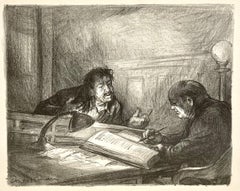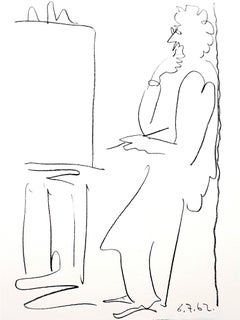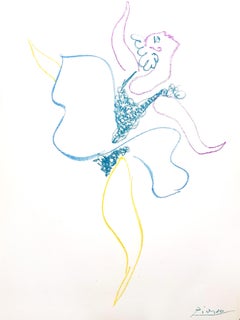Don Freeman Art
to
2
2
1
1
Overall Height
to
Overall Width
to
2
2
1
1
1
2
1
2
6,910
3,229
2,514
1,217
2
Artist: Don Freeman
ASTOR LOBBY, SHOWTIME
By Don Freeman
Located in Portland, ME
Freeman, Don (American, 1908-1978). ASTOR LOBBY,SHOWTIME. McCulloch 34. Lithograph, 1932. Edition of 30 or fewer. Signed in pencil lower right. 8 7/8 x 11 1/8, 225 x 283 mm.(image), ...
Category
1930s Don Freeman Art
Materials
Lithograph
Don Freeman, (At the Booking Desk)
By Don Freeman
Located in New York, NY
Don Freeman is best known for his paintings and works on paper of New York City's theatre industry: the signage, the stages and sets, the actors, the costumers and ushers, anything a...
Category
Mid-20th Century Ashcan School Don Freeman Art
Materials
Lithograph
Related Items
Pablo Picasso - The Painter - Original Lithograph
By Pablo Picasso
Located in Collonge Bellerive, Geneve, CH
Pablo Picasso - Original Lithograph
Title: Painter and his Model
From the illustrated book "Regards sur Paris" (Paris: André Sauret, 1962)
Edition of 180
Individual prints were not s...
Category
1960s Modern Don Freeman Art
Materials
Lithograph
Pablo Picasso - The Ballet Dancer - Original Lithograph
By Pablo Picasso
Located in Collonge Bellerive, Geneve, CH
Pablo Picasso - Original Lithograph
Title: The Ballet Dancer
Dimensions: 32 x 24 cm
1954
Reference: Bloch 767
Frontispiece for the book "Le Ballet" (Paris: Editions Hachet, 1954) by...
Category
1950s Modern Don Freeman Art
Materials
Lithograph
H 12.6 in W 9.45 in D 0.04 in
Mexican Revolution Portrait (3)
Located in Columbia, MO
Artist Unknown
Mexican Revolution Portrait (3)
1972
Lithograph (poster) reproduction of original photograph c. 1917
24 x 14 inches
26.5 x 20.5 (framed)
Category
20th Century Contemporary Don Freeman Art
Materials
Silver Gelatin, Lithograph
Jean Cocteau - Young Girl - Original Lithograph
By Jean Cocteau
Located in Collonge Bellerive, Geneve, CH
Jean Cocteau - Young Girl - Original Lithograph
Signed and dated in the plate
Stampsigned
Dimensions: 53 x 42 cm
1956
Provenance : Succession Dermit, Cocteau's heir
Category
1950s Modern Don Freeman Art
Materials
Lithograph
Still Life with Hans Maler Pop Art Serigraph Hand Signed
By Josef Levi
Located in Surfside, FL
On deckle edged watermarked Arches French paper. hand signed in pencil, dated and numbered. the edition size is 175.
there are three states of the same image image each with increasing detail and color. This is just for the one in the photo.
Josef Alan Levi (1938) is an American artist whose works range over a number of different styles, but which are unified by certain themes consistently present among them. Josef Levi began his artistic career in the 1960s and early '70s, producing highly abstract and very modernist pieces: these employing exotic materials such as light fixtures and metallic parts. By 1975, Levy had transitioned to painting and drawing still lifes. At first these were, traditionally, of mundane subjects. Later, he would depict images from art history, including figures originally created by the Old Masters. Around 1980, he made another important shift, this time toward creating highly precise, though subtly altered reproductions of pairs of female faces which were originally produced by other artists. It is perhaps this work for which he is most well known. Since around 2000, Josef Levi has changed the style of his work yet again: now he works entirely with computers, using digital techniques to abstract greatly from art history, and also from other sources.
Levi's works of art in the collections of the Museum of Modern Art, NYC, the National Gallery of Art, and the Albright-Knox Museum, among many others. Levi's art has been featured on the cover of Harper's Magazine twice, once in June 1987, and once in May 1997.
Josef Levi received a Bachelor of Arts degree in 1959 from the University of Connecticut, where he majored in fine arts and minored in literature. From 1959 to 1960, he served to a first lieutenant in the U.S. Army, and from 1960 through 1967 he was in the U.S. Army Reserves.
In 1966, he received the Purchase Award from the University of Illinois in 1966, and he was featured in New Talent U.S.A. by Art in America. He was an artist in residence at Appalachian State University in 1969, taught at Farleigh Dickenson University in 1971 and was a visiting professor of art at Pennsylvania State University in 1977. From 1975 to 2007, Levi resided in New York City. He now lives in an apartment in Rome, where he is able to paint with natural light as he was unable in New York.
From 1959 to 1960, Josef took some courses of Howard McParlin Davis and Meyer Schapiro at Columbia University which initiated him into the techniques of reproducing the works of the Old Masters. His first works, created in the 1960s, were wood and stone sculptures of women. His first mature works were abstract pieces, constructed of electric lights and steel.
In 1970, Levi's materials included fluorescent light bulbs, Rust-Oleum and perforated metal in addition to paint and canvas.
By 1980, Josef Levi's art had transformed into a very specific form: a combination of reproductions of female faces which were originally depicted by other artists. The faces which he reproduces may be derived from either portraits or from small portions of much larger works; they are taken from paintings of the Old Masters, Japanese ukiyo-e, and 20th-century art. Artists from whom he has borrowed include: Vermeer, Rembrandt, Piero della Francesca, Botero, Matisse, Utamaro, Correggio, Da Vinci, Picasso, Chuck Close, Max Beckmann, Pisanello, Lichtenstein. The creation of these works is informed by Levi's knowledge and study of art history.
Josef Levi's paintings from this period are drawn, then painted on fine linen canvas on wooden stretchers. The canvas is coated with twenty-five layers of gesso in order to produce a smooth surface on which to work. The drawing phase takes at least one month. Levi seals the drawing with acrylic varnish, and then he may apply layers of transparent acrylic in order to approximate the look of old paintings. After the last paint is applied, another layer of acrylic varnish is sprayed on to protect the work.
Most of the figures in his contemporary pieces are not paired with any others.
SELECTED COLLECTIONS
MUSEUM OF MODERN ART, NEW YORK, NY
ALBRIGHT- KNOX GALLERY, BUFFALO, NY
ALDRICH MUSEUM OF CONTEMPORARY ART, RIDGEFIELD, CT
NATIONAL GALLERY OF ART, WASHINGTON, DC
BROOKLYN MUSEUM OF ART, BROOKLYN, NY
SMITHSONIAN NATIONAL MUSEUM OF AMERICAN HISTORY, WASHINGTON, DC
CORCORAN GALLERY, WASHINGTON, DC
UNIVERSITY OF NOTRE DAME ART...
Category
1970s Pop Art Don Freeman Art
Materials
Lithograph, Screen
After Pablo Picasso - Don Quixote - Lithograph
By (after) Pablo Picasso
Located in Collonge Bellerive, Geneve, CH
After PABLO PICASSO (1881-1973)
Don Quixote
1955
Dimensions: 65 x 50 cm
Printed signature and date
Edition Succession Picasso, Paris (posthumous reproductive edition)
Editions de la ...
Category
1950s Surrealist Don Freeman Art
Materials
Lithograph
Vintage Russian Ukrainian Soldiers in Forest Scene Judaica Lithograph Jewish Art
By Anatoli Lvovich Kaplan
Located in Surfside, FL
Pencil signed and dated, Russian Soviet Judaica Lithograph.
Anatoli Lwowitch Kaplan was a Russian painter, sculptor and printmaker, whose works often reflect his Jewish origins.
His...
Category
Mid-20th Century Modern Don Freeman Art
Materials
Lithograph
Full Length Mirror
Located in Columbia, MO
Full Length Mirror
Lithograph 16/20
14 x 10 inches
Framed: 22 x 18 inches
Category
21st Century and Contemporary Contemporary Don Freeman Art
Materials
Lithograph
Vintage Russian Ukrainian Shtetl Scene Judaica Lithograph Jewish Portrait
By Anatoli Lvovich Kaplan
Located in Surfside, FL
Pencil signed and dated, Judaica Lithograph.
Anatoli Lwowitch Kaplan was a Russian painter, sculptor and printmaker, whose works often reflect his Jewish origins.
His father was a b...
Category
Mid-20th Century Modern Don Freeman Art
Materials
Lithograph
Marc Chagall - Original Lithograph
By Marc Chagall
Located in Collonge Bellerive, Geneve, CH
Marc Chagall
Original Lithograph
1963
Dimensions: 32 x 24 cm
Reference: Chagall Lithographe 1957-1962. VOLUME II.
Condition : Excellent
Marc Chagall (born in 1887)
Marc Chagall was born in Belarus in 1887 and developed an early interest in art. After studying painting, in 1907 he left Russia for Paris, where he lived in an artist colony on the city’s outskirts. Fusing his own personal, dreamlike imagery with hints of the fauvism and cubism popular in France at the time, Chagall created his most lasting work—including I and the Village (1911)—some of which would be featured in the Salon des Indépendants exhibitions. After returning to Vitebsk for a visit in 1914, the outbreak of WWI trapped Chagall in Russia. He returned to France in 1923 but was forced to flee the country and Nazi persecution during WWII. Finding asylum in the U.S., Chagall became involved in set and costume design before returning to France in 1948. In his later years, he experimented with new art forms and was commissioned to produce numerous large-scale works. Chagall died in St.-Paul-de-Vence in 1985.
The Village
Marc Chagall was born in a small Hassidic community on the outskirts of Vitebsk, Belarus, on July 7, 1887. His father was a fishmonger, and his mother ran a small sundries shop in the village. As a child, Chagall attended the Jewish elementary school, where he studied Hebrew and the Bible, before later attending the Russian public school. He began to learn the fundamentals of drawing during this time, but perhaps more importantly, he absorbed the world around him, storing away the imagery and themes that would feature largely in most of his later work.
At age 19 Chagall enrolled at a private, all-Jewish art school and began his formal education in painting, studying briefly with portrait artist Yehuda Pen. However, he left the school after several months, moving to St. Petersburg in 1907 to study at the Imperial Society for the Protection of Fine Arts. The following year, he enrolled at the Svanseva School, studying with set designer Léon Bakst, whose work had been featured in Sergei Diaghilev's Ballets Russes. This early experience would prove important to Chagall’s later career as well.
Despite this formal instruction, and the widespread popularity of realism in Russia at the time, Chagall was already establishing his own personal style, which featured a more dreamlike unreality and the people, places and imagery that were close to his heart. Some examples from this period are his Window Vitebsk (1908) and My Fianceé with Black Gloves (1909), which pictured Bella Rosenfeld, to whom he had recently become engaged.
The Beehive
Despite his romance with Bella, in 1911 an allowance from Russian parliament member and art patron Maxim Binaver enabled Chagall to move to Paris, France. After settling briefly in the Montparnasse neighborhood, Chagall moved further afield to an artist colony known as La Ruche (“The Beehive”), where he began to work side by side with abstract painters such as Amedeo Modigliani and Fernand Léger as well as the avant-garde poet Guillaume Apollinaire. At their urging, and under the influence of the wildly popular fauvism and cubism, Chagall lightened his palette and pushed his style ever further from reality. I and the Village (1911) and Homage to Apollinaire (1912) are among his early Parisian works, widely considered to be his most successful and representative period.
Though his work stood stylistically apart from his cubist contemporaries, from 1912 to 1914 Chagall exhibited several paintings at the annual Salon des Indépendants exhibition, where works by the likes of Juan Gris, Marcel Duchamp and Robert Delaunay were causing a stir in the Paris art world. Chagall’s popularity began to spread beyond La Ruche, and in May 1914 he traveled to Berlin to help organize his first solo exhibition, at Der Sturm Gallery. Chagall remained in the city until the highly acclaimed show opened that June. He then returned to Vitebsk, unaware of the fateful events to come.
War, Peace and Revolution
In August 1914 the outbreak of World War I precluded Chagall’s plans to return to Paris. The conflict did little to stem the flow of his creative output, however, instead merely giving him direct access to the childhood scenes so essential to his work, as seen in paintings such as Jew in Green (1914) and Over Vitebsk (1914). His paintings from this period also occasionally featured images of the war’s impact on the region, as with Wounded Soldier (1914) and Marching (1915). But despite the hardships of life during wartime, this would also prove to be a joyful period for Chagall. In July 1915 he married Bella, and she gave birth to a daughter, Ida, the following year. Their appearance in works such as Birthday (1915), Bella and Ida by the Window (1917) and several of his “Lovers” paintings give a glimpse of the island of domestic bliss that was Chagall’s amidst the chaos.
To avoid military service and stay with his new family, Chagall took a position as a clerk in the Ministry of War Economy in St. Petersburg. While there he began work on his autobiography and also immersed himself in the local art scene, befriending novelist Boris Pasternak, among others. He also exhibited his work in the city and soon gained considerable recognition. That notoriety would prove important in the aftermath of the 1917 Russian Revolution when he was appointed as the Commissar of Fine Arts in Vitebsk. In his new post, Chagall undertook various projects in the region, including the 1919 founding of the Academy of the Arts. Despite these endeavors, differences among his colleagues eventually disillusioned Chagall. In 1920 he relinquished his position and moved his family to Moscow, the post-revolution capital of Russia.
In Moscow, Chagall was soon commissioned to create sets and costumes for various productions at the Moscow State Yiddish Theater...
Category
1960s Surrealist Don Freeman Art
Materials
Lithograph
Amazone et Tonneau
Located in Columbia, MO
HENRI DE TOULOUSE-LAUTREC
Amazone et Tonneau
1948
Lithograph on paper
Ed. 166/740
20.5 x 14 inches
Category
19th Century Post-Impressionist Don Freeman Art
Materials
Lithograph
Mexican Revolution Portrait (1)
Located in Columbia, MO
Artist Unknown
Mexican Revolution Portrait (1)
1972
Lithograph (poster) reproduction of original photograph c. 1917
24 x 14 inches
26.5 x 20.5 (framed)
Category
20th Century Contemporary Don Freeman Art
Materials
Lithograph, Silver Gelatin
Previously Available Items
"City Holiday, " New York City Modern American Scene WPA Modern Art Drawing NYC
By Don Freeman
Located in New York, NY
A student of John Sloan at the Art Students League in New York, Freeman created drawings of the theater, which were published in the Herald Tribune, New York Times, and Theater Magaz...
Category
Early 19th Century American Realist Don Freeman Art
Materials
Paper, Oil
Ladies of The Evening
By Don Freeman
Located in Santa Monica, CA
DON FREEMAN (1908-1978)
LADIES OF THE EVENING 1937 (McCulluch 117)
Color lithograph, edition 50. Signed & titled. 9 1/8 x 6 ¼”. $575
Category
1930s Realist Don Freeman Art
Materials
Lithograph
Night Life
By Don Freeman
Located in Los Angeles, CA
DON FREEMAN
"NIGHT LIFE"
OIL ON PANEL, SIGNED, TITLED
AMERICAN, C.1940
29.5 X 21 INCHES
Don Freeman
1908-1978
Illustrator, painter and ...
Category
1930s Ashcan School Don Freeman Art
Materials
Board, Oil
Don Freeman art for sale on 1stDibs.
Find a wide variety of authentic Don Freeman art available for sale on 1stDibs. You can also browse by medium to find art by Don Freeman in lithograph and more. Not every interior allows for large Don Freeman art, so small editions measuring 11 inches across are available. Customers who are interested in this artist might also find the work of James Penney, John Sloan, and George Wesley Bellows. Don Freeman art prices can differ depending upon medium, time period and other attributes. On 1stDibs, the price for these items starts at $300 and tops out at $875, while the average work can sell for $588.




